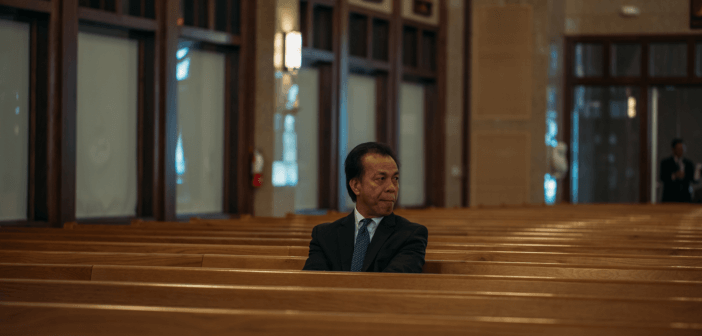A sustained decline in worship attendance is afflicting most American congregations. Drawing on findings from the Lewis Center’s Religious Workforce Project, Lovett H. Weems Jr. outlines ways congregations can respond to declining attendance and how the trend impacts the deployment of clergy and other congregational leaders.
The Religious Workforce Project of the Lewis Center is a multiyear effort to understand the changing religious landscape in the 21st century. Funded by the Lilly Endowment, Inc., the project explores how congregations are adapting, especially in their workforce. This article is part of a series featuring insights from the research.
The median attendance among U.S. congregations has declined consistently through the first decades of the 21st century. Once most noticeable among mainline churches, the decline is increasingly characteristic of Christian traditions overall, even among some denominations that previously experienced sustained growth. Some mainline denominations showing membership and attendance losses since the 1960s found the 1990s to be a relatively stable decade for attendance, with some denominations reporting increased annual attendance in some years. But that stability lasted only through 2001, after which a sustained decline in attendance began that continues today, accelerated by the pandemic and the rise of the nones, those claiming no religious affiliation.
The size of a church matters.
There is an exception to the declining worship attendance trend. Larger churches continue to grow. The Faith Communities Today 2020 survey found that since 2015, a majority (71%) of congregations with worship attendance of 1,500 or more were growing. Despite increased attendance in the largest of churches, the rate of attendance based on membership continues to be stronger among smaller congregations according to research from David Eagle. However, the continued movement of worshipers toward larger congregations permits the larger churches to grow even with lower participation rates.
Churches showing the greatest declines in attendance are the smallest—those that average 50 or fewer in worship. There are more mixed patterns of growth and decline among churches with attendance between the smallest and largest congregations, though decline is more common than growth. Despite higher per capita giving and attendance, some smaller congregations are approaching a tipping point, with fewer and increasingly older members, which may make their congregations unsustainable.
How can congregations respond to declining attendance?
1. Seek to reach more people, younger people, and more diverse people. Long-established churches often find it difficult to reach newer populations that are different from them. A renewed interest in reaching beyond traditional racial, class, and age constituencies could lead to an increase in those experiencing God’s love through Christ in worship. The future is limited for churches that are unable to reach more people, younger people, and more diverse people.
2. Implement new financial models. Many congregations are considering creative options to maintain their ministries under new circumstances. In addition to church mergers or sharing pastors, congregations are finding ways to reduce expenses or increase income by rethinking how their land and facilities can become assets for future viability.
3. Develop new worship models. Churches of all sizes need to build on the uses of technology that many developed during the pandemic. Smaller churches not only found this effort more difficult due to finances and expertise, but they are also more often reluctant to continue online services beyond the pandemic. Churches of all sizes need a digital option for worship, and they need to improve the quality of these offerings week by week.
4. Engage people beyond worship. Church is more than worship. Even as churches work hard to reach more people in worship, they must also strengthen other ways of connecting with people and building relationships that lead to more active discipleship beyond worship. Engagement is the key. As even the most faithful members attend worship less frequently, it is important to provide a range of ways for people to engage their faith and one another.
5. Focus on your surrounding community. No congregation’s future is located within the walls of the church. That future is where it was when the church began, even if centuries ago—in the community and among the people God has given the congregation to serve.
What are the likely changes for clergy and other church leaders?
1. More part-time clergy. Falling median worship attendance figures will likely lead to fewer pastors who are full-time, and more that are part-time or in shared pastor arrangements.
2. More bivocational clergy. An increasing number of clergy may need to be bivocational, even among those with seminary degrees.
3. More lay pastors. The number of laity serving in various approved pastoral roles probably will continue to expand.
4. New opportunities in larger churches. Growing large churches will continue to be the churches of choice for most who attend worship. These churches will need both clergy and lay professionals as part of their workforce.
5. More lay ministry opportunities. Churches are rediscovering ministry models that utilize the gifts of an array of persons in addition to the pastoral leaders of the congregation. Some changes come from necessity, and many arise as laity to use their talents for the mission of the congregation and the needs of the community.
A challenging time
As the 21st century progresses, Christian movements in the U.S. may face their greatest challenge since they faced the American frontier of the 19th century. Hoping for a return to a simpler and more hospitable time for Christian churches wastes valuable time. Know that this is the season for which you are called as clergy and laity.
Pastors may daydream about the church they hope to serve one day that is free from the problems of their current congregation. There is no such church, not even in the Bible! A better approach is to work every day to make your current church into the kind of church that God and the world most need.
Related Resources
- The Religious Workforce Project
- Religious Workforce Project reports
- Improving Worship Attendance in a Post-Pandemic World, Video Webinar
- 50 Ways to Increase Worship Attendance, a free Lewis Center Resource
- Why Worship Attendance Matters and Clues for Improving It, a free video resource featuring Dr. Lovett H. Weems Jr.






